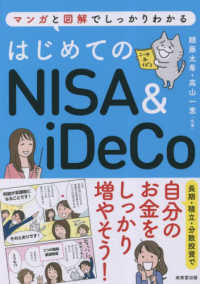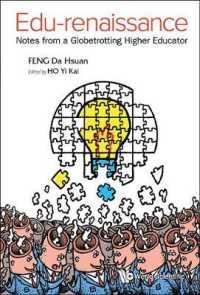- ホーム
- > 洋書
- > 英文書
- > Business / Economics
基本説明
It addresses the roles and responsibilities of the CFO to enhance security, controls, and privacy.
Full Description
Praise for IT Best Practices "The work of the financial manager revolves around a company's financial systems. Ms. Roehl-Anderson's latest offering addresses the two key aspects of these systems—how to buy and install them. The book covers every conceivable aspect of these systems, including ERP, software as a service, shared services, and supporting controls. As a bonus, the book contains substantial coverage of information technology considerations in an acquisition. This is a definitive desk reference." —Steve Bragg, CFO, XeDAR Corporation, and author of Accounting Best Practices
"Sage advice from one of the most adept project managers in the industry! Jan and team have delivered a practical, yet comprehensive guidebook for software selection, implementation, rollout, and ongoing updates. This guidebook will become a valuable reference for every financial manager and IT project manager undertaking ERP implementation."—Valerie Borthwick, former senior vice president, Oracle Consulting
"Written by one of the best in the IT business, this book is a must-read for all CFOs and controllers. In one volume, it addresses everything a financial executive needs to know about IT and its impact on the financial function, while also featuring practical guidelines, current hot topics, and IT best practices. This book covers it all."—Jo Marie Dancik, Regional Managing Partner (Retired), Ernst & Young
Contents
Preface. Acknowledgments.
About the Contributors.
PART I THE BASICS.
CHAPTER 1 The Information Technology Planning Process.
Finance and Information Systems.
Information Technology Planning Process.
The Role of Finance in the Systems Planning Process.
Conclusion.
CHAPTER 2 ERP Software Selection.
Project Preparation, Scope Definition and Approach.
Vendor Candidate Identification and Short Listing.
Request for Information/Request for Proposal Analysis, Vendor Demonstrations, and References.
Preliminary Vendor Recommendation and Negotiations.
Final Vendor Decision and Procurement.
Conclusion.
CHAPTER 3 The Software Implementation Process.
Key Implementation Concepts.
The Implementation Phases in Detail.
Common Risks and Mitigation Strategies.
Areas that Require Special Attention from the CFO.
Conclusion.
CHAPTER 4 Critical Success Factors for IT Implementations.
Provide Effective Sponsorship.
Select a Dedicated and Experienced Project Team.
Establish Project Infrastructure.
Utilize a Well-Established Approach.
Address People Issues.
Communicate.
Manage Scope.
Establish a Supportive Culture.
Conduct Periodic Quality Assurance Reviews.
Provide a Stable Technical Environment.
Conclusion.
CHAPTER 5 Steering Clear of a "Crisis in Confidence" and Other People Pitfalls.
Phase 1: Before the Project.
Phase 2: During the Project.
Phase 3: After the Project.
Conclusion.
CHAPTER 6 Objectives and Scope of Implementing Automated Financial Systems.
Objectives.
Core (First-Tier) Applications.
Second-Tier Applications.
Tier Two Applications.
Third-Tier Applications and Beyond.
Conclusion.
PART II IT HOT TOPICS.
CHAPTER 7 Shared Services and Financial Systems.
Creating Value through Financial Systems-Enabled Shared Services.
Financial Systems as a Foundation for Shared Services Benefits Realization.
SSC and Financial Systems Implementation Considerations.
Financial Executive's Role in Shared Services Implementations.
Conclusion.
CHAPTER 8 Globalization Trends in Offshore Information Technology.
How Is Global IT Different from Offshore IT?
How Globalization of Business Has Influenced Global IT.
How Pervasive IT Influenced Global IT.
How Global IT Continues to Drive Changes in Globalized Business.
Conclusion.
CHAPTER 9 Security, Controls, and Privacy.
Impact of Sarbanes-Oxley on Financial System Implementations.
Financial Executive's Role in the Security, Controls, and Privacy Area.
Security, Control, and Privacy Safeguard Design.
Controls Automation.
Ways to Test Controls.
Conclusion.
CHAPTER 10 What Is IFRS and Why Is It Relevant to the CFO Now?
History and Specifics of IFRS.
Some Key Differences between IFRS and U.S. GAAP.
Potential Benefits of Reporting under IFRS.
Potential "Costs" or Cons of Reporting under IFRS.
The Decision to Move to IFRS.
IFRS Conversion Project Approach.
Conclusion.
Notes.
CHAPTER 11 The Phenomenon of Software as a Service.
Background: What Is SaaS?
The Value Proposition of SaaS.
Making the Right Decision: Is SaaS Right for Me?
Implications to IT Organizations.
Conclusion.
CHAPTER 12 Investing in Product Information Management.
Overview.
PIM Adaptation Catalysts.
PIM Implementation Considerations.
PIM Return on Investment.
Conclusion.
Note.
CHAPTER 13 E-Commerce.
E-Commerce Defined.
E-Commerce Today.
Increasing Shareholder Value.
Justifying the Investment.
Implementing Financial Controls for E-Commerce.
Conclusion.
CHAPTER 14 ERP: An Evolving Process.
Getting Started.
You Have Identified the Problem, Now You Need to Define the Solution.
Conclusion.
PART III MERGERS, ACQUISITIONS, DIVESTITURES, AND IT.
CHAPTER 15 Key IT-Related Questions Every Financial Executive Should Consider during a Merger, Acquisition, or Divestiture.
Before a Transaction Is Identified.
After a Transaction Is Identified.
Conclusion.
Notes.
CHAPTER 16 The Importance of IT Due Diligence during a Merger or Acquisition.
Why Bother With IT Due Diligence?
Role of the Chief Information Officer.
Looking Under the Hood: Your IT Due Diligence Checklist.
How to Get the Data?
Beyond Cost Reduction: Identifying IT Synergies.
Accelerating Merger Integration Planning through Due Diligence.
Due Diligence after the Close.
Conclusion.
CHAPTER 17 Ways to Enhance IT-Related Synergy Capture during a Merger, Acquisition, or Divestiture.
Sources of IT Synergies.
Benchmarks to Establish IT Synergy Targets.
Begin Early and Build Momentum.
Conclusion.
CHAPTER 18 Ways to Reduce IT-Related Costs during a Merger, Acquisition, or Divestiture.
Approach.
Cost Reduction during Merger or Acquisition.
Cost Reduction during Divesture.
Conclusion.
CHAPTER 19 Effective Approaches for Managing IT during a Merger, Acquisition, or Divestiture.
New Terminology.
Faster Pace.
New Challenges for IT.
Conclusion.
CHAPTER 20 Ways to Use Mergers, Acquisitions, or Divestitures to Build Sustainable Information Technology Value.
Divestitures to Build Sustainable Information Technology Value.
Conclusion.
CHAPTER 21 Time-Tested Approaches to Maintaining Data Integrity during a Merger, Acquisition, or Divestiture.
Potential Impacts of Poor-Quality Data.
Time-Tested Approaches to Help Maintain the Integrity of the Data.
Conclusion.
Glossary.
About the Author.
Index.
-

- 電子書籍
- 神童と猛獣 ラブラブ編 2
-

- 洋書
- Hobo Stories






